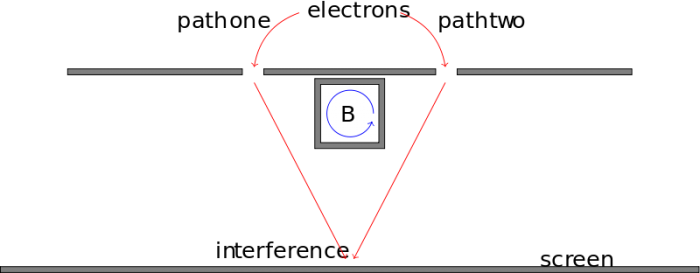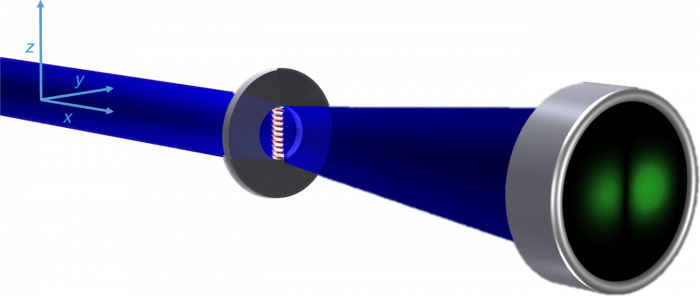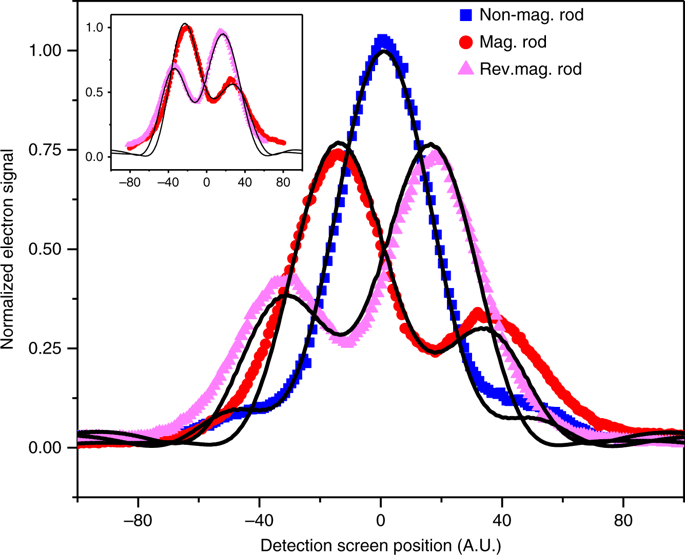
Since the time of Galileo and Newton, physicists have believed we live in a classical world—that is, a world that obeys the laws of classical physics. Space was seen to be Euclidean, nature was believed to be continuous, and motions were seen to be caused by action-reaction force pairs.
At the dawn of the 20 century, the first two assumptions were shown to be false. General relativity describes spaces as non-Euclidean and quantum mechanics seems to imply that nature is discontinuous and “gappy.” The third condition, the fact that forces always come in action-reaction pairs, is a consequence of Newton’s third law of motion:
“For every action, there is an equal and opposite reaction” – Newton’s third law of motion
Newton’s third law tells us that forces only exist in pairs; that is, wherever there is one force, there must be an equal and opposite force accompanying it. For example, when you push on a wall with some force, the wall pushes back with the same amount of force in the opposite direction. As you act on the wall, the wall simultaneously acts on you. Similarly with gravity. Objects exert mutual gravitational influences on each other. The gravity of the sun exerts a force on the Earth, and the Earth exerts a force back on the sun.
Well, now we have pretty good reason to think that Newton’s third law is false too, or at least false under certain circumstances. A recent experiment performed by a joint team of scientists from the University of Nebraska and the University of Antwerp seems to indicate the existence of a mysterious “quantum force” that can affect the motion of an electron without itself being acted on by the electron.
The researchers specific findings relate to something known as the “Aharonov-Bohm effect.” In short, the Aharonov-Bohm effect is a quantum mechanical phenomena in which an electrically charged particle is affected by an electromagnetic potential, despite being in a region where the magnetic and electric field are both 0. The Aharonov-Bohm effect was first mathematically predicted in 1959 by Yakir Aharonov and David Bohm and was first experimentally confirmed in 1986 by Japanese physicist Akira Tonomura.

An illustration of the Aharonov-Bohm effect. Electrons have their path deflected by the electric potential in the absence of an electric field. Credit: “Aharonov-Bohm effect” by S. Schmittner via WikiCommons CC-BY-SA 3.0
The current study seems to imply that the Aharonov-Bohm effect is due to the action of a previously undiscovered “quantum force;” an entity that affects motion like classical forces but has some strange properties. Specifically, this force is seen to be non-local and non-Newtonian.
Electric Fields and Electric Potentials
Let’s talk a bit about electric fields and electric potentials. In classical mechanics, charged objects like electrons create an electric field. An electric field is mathematically described as a vector field, an abstract space in which every point in that space is assigned a magnitude and a direction. The magnitude and directions of the field represent the strength and direction of the electric force that the field would exert on a positively charged particle in that spot. Think of the electric field as a region of space where every point in that space is associated with some intrinsic “pull” or “push.”
There is also what is known as the electric potential. The electric potential represents the amount of work necessary to move a charged particle from one point in the field to another—how hard you have to push it to move it around. The electrical potential at a point is exactly equal to the electrical potential energy contained in a charged particle at that point. One can see the electric potential as a measure of how quickly the strength of the electric field changes over a given distance. The electric potential is a scalar quantity (only has a magnitude) and only depends on the location of the particle with respect to a chosen reference point.
For much of the history of electrodynamics, electric potentials were not considered to have any physical reality and were only seen as a useful mathematical tool for calculating the characteristics of the electric field at some point. However, the discovery of the Aharonov-Bohm effect is generally interpreted as showing that, to the contrary, electric potentials are genuine existent entities that have causal effects on matter. Much subsequent work on the Aharonov-Bohm effect has been focused on determining the nature of this apparent causal interaction between the electric potential and charged particles.
Zeilinger, Shelankov, And Further Work
In 1998, the physicist Anton Zeilinger posited that the Aharonov-Bohm effect does not arise from any forces and instead is the result of the “dispersionless” nature of the electric potential. His reasoning was that, if the observed electron diffractions were caused by a force, then we would see a time delay from the original prediction of electron motion. Since experiments did not seem to show this delay, he concluded that forces cannot be in play. Another work by the physicist Andrei Shalankov predicted that instead of a time delay, the action of a force could manifest as electron deflection instead of a time delay.

The experimental setup in the study. An electron beam was directed past a magnetized solenoid. Credit: Becker et. al. “Asymmetry and non-dispersivity in the Aharonov-Bohm effect” DOI: <https://doi.org/10.1038/s41467-019-09609-9> licensed under CC-BY 4.0
The current study was meant to test Zeilinger’s theorem and Shelankov’s predictions by measuring any possible electron position diffraction that would result from a hidden force. To test this claim, the researchers set up an experimental apparatus that involves firing a beam of electrons at a magnetically charged solenoid whose electromagnetic field is shielded from the particles.
When the bar was not magnetized, the electrons sailed right by the side of the solenoid without any perturbation. However, once they ramped up the magnetization, the researchers observed the predicted asymmetrical electron diffraction pattern in the transverse direction. Reversing the magnetic charge reversed the orientation of the observed asymmetries, indicating that the electromagnetic potential of the solenoid system was having a causal effect on the particles. The key thing here is that the electrons were traveling through a space where there is no influence of the electromagnetic field. There is, however, an electric potential in this region, and that determines how the particles are deflected.

A graph showing the asymmetrical diffraction patterns. The blue line represents the path when the bar is not magnetized. The red and pink lines are the path when the bar is magnetized and when the magnetization is reversed. Credit: Becker et. al. “Asymmetry and non-dispersivity in the Aharonov-Bohm effect” DOI <https://doi.org/10.1038/s41467-019-09609-9> licensed under CC-BY 4.0
So let’s go over these results explicitly: Zeilinger predicted that any action of force in this system would result in a time delay in the arrival of electrons at the desired point. Sheleankov responded that, on the contrary, all that needs to be observed to indicate the action of a force is positional diffraction, not a time delay. The current experiment shows that both claims can be true, there is no time delay and there is positional diffraction; it seems both Zeilinger and Shelankov’s predictions can both be true, there just needs to be a special kind of force; a “quantum force”, if you will.
“Quantum Force”
What do we make of the nature of this supposed “force”? Well, first of all, the action of the force seems to be non-local; that is, it can act instantaneously over distances. The fact that there is no observed time-delay in the setup indicates that the supposed force does not require any time to propagate and act on electrons. While non-local forces are certainly a no-go in classical physics, quantum physicists are familiar with non-local mechanisms. Specifically, quantum entanglement seems to involve the instantaneous interaction of two spatially separated particles. According to the study lead Herman Batelaan, their results could be interpreted as the action of a similar non-local force like that of quantum entanglement.
Second, the supposed force would have to be non–Newtonian, in the sense that it violates Newton’s third law. This result comes along with the realization that, even though the electric potential acts on the electron, the electron itself does not act on the electric potential. In classical physics, wherever there is a force, there must be an accompanying equal and opposite force. Not so with the Aharonov-Bohm effect. According to Batelaan, this “quantum force,” unlike quantum entanglement, “is a one-particle phenomenon, not a two-particle phenomenon.” Thus this “quantum force” would have the unique property of being able to act on objects without that objects acting back on them.
Batelaan and co. interpret their results in the context of the deBroglie-Bohm pilot wave interpretation of quantum mechanics. According to this interpretation, quantum systems have two parts, the wave function (pilot wave) and the actual particles in definite positions. The general idea is that the pilot wave guides the particles through the action of a force called the “quantum potential.” The trick with the pilot wave interpretation is that this quantum potential cannot be directly measured, only indirectly. So, if the deBroglie-Bohm interpretation of quantum mechanics is correct, then this quantum potential could manifest as a force acting on particles to change their trajectories.
Of course, the deBroglie-Bohm interpretation of quantum mechanics is not without controversy. Parts of these criticisms relate to the fact that deBroglie-Bohm wave mechanics are explicitly formulated as non–local, i.e., any change to the wave function instantaneously changes the position of the guided particles. The non-local nature of deBroglie-Bohm mechanics seems to be in direct violation of the theory of relativity and its constraint that superluminal instantaneous propagation of causality is impossible. According to Batelaan, the non-locality of this possible force is the single biggest takeaway from the experiment: “I feel that this underlines the idea that nature might be non-local. This is a big question. Do the things I do here affect things somewhere else, without a clear intermediary?”
So what do we make of these results? On the one hand, quantum mechanics is known for being extra weird, so the existence of a previously unknown force that behaves differently than classical forces is not completely out of the realm of possibility. On the other hand, admitting the existence of such a non-local non-Newtonian force seems to fly in the face of a substantial portion of what we know about forces and motion.
However, the study by Batelaan and co. indicates that there certainly is something strange going on in these kinds of experiments, something that we do not currently have the right tools to explain. Perhaps as our knowledge of the quantum realm increases, we will find more evidence of other “quantum forces” that can fill in the gaps of our scientific knowledge.









